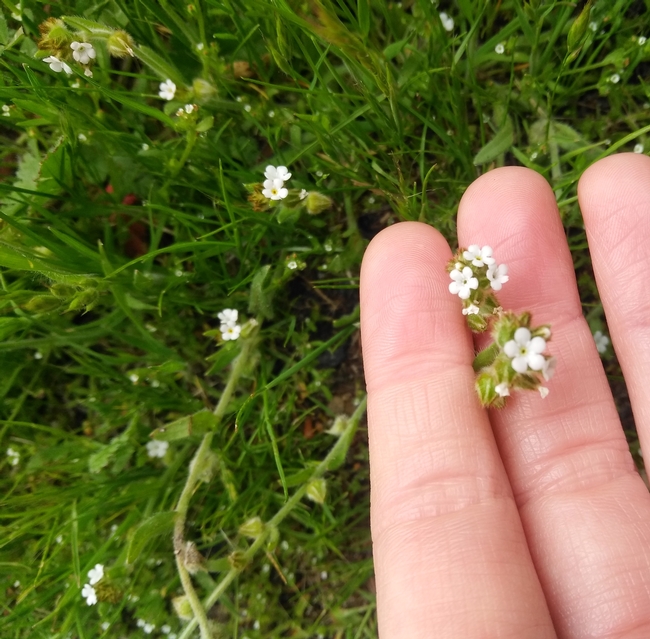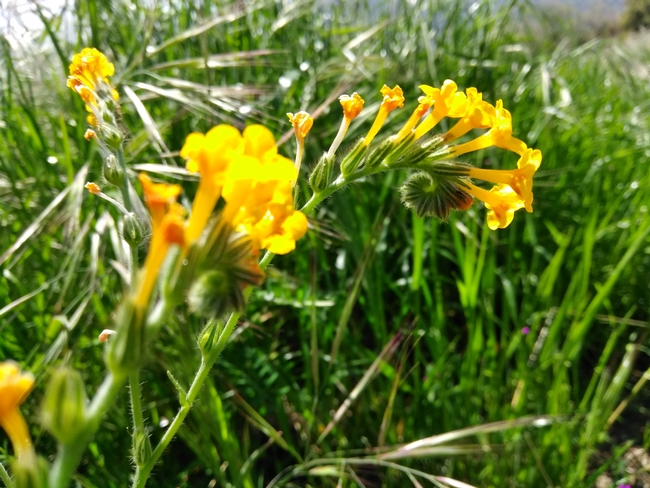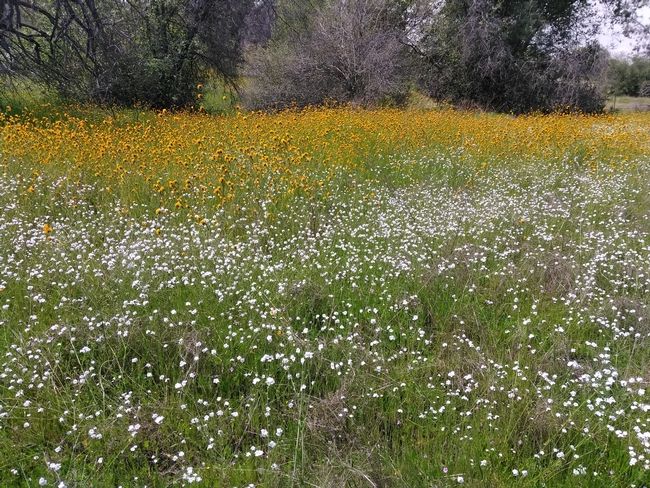- Author: Rebecca Ozeran
A few months ago, I was asked about the toxicity of various plants in a horse pasture after the death of a miniature horse using that pasture. While many of the identified plants were chemically harmless (such as filaree [Erodium spp] and some native clovers), the pasture did have fiddleneck (Amsinckia spp) and popcorn flower (Plagiobothrys spp), two native forbs with potentially toxic chemistry.
Popcorn flower (above) has small white flowers. Fiddleneck (below) has slightly larger yellow flowers. Both plants have similar overall shapes: slender flowering stems, relatively small leaves, and hairs on all parts except the flowers themselves.
Fiddleneck is a known alkaloid accumulator and popcorn flower is similarly suspected to accumulate alkaloids. There are no cases that I have found where popcorn flower was identified as a cause of toxicity, however. Most research on popcorn flower chemistry focuses on insect herbivores which like to eat plants with alkaloids, to protect themselves against predation (e.g. Hartmann et al. 2004) – but that's a topic for another blog!
Alkaloids are secondary organic compounds produced by many plants. Different types of alkaloids have different interactions with animal biology, some of which are benign or beneficial, and others which are harmful. Some alkaloids you may have heard of include morphine, nicotine, and quinine. Pyrrolidizine alkaloids, the type found in fiddleneck and popcorn flower, have harmful effects. Toxicity often occurs when animals eat feed or hay contaminated with fiddleneck seeds, and some cases have been documented from animals grazing the plant in a pasture. Fiddleneck alkaloids can cause liver disease and death of horses, cattle, and pigs, but sheep seem to be less vulnerable (Craig et al. 1985).
Both fiddleneck and popcorn flower may also accumulate nitrates. Nitrates convert into nitrites once the animal eats the plant. Nitrites then react with hemoglobin in the blood and make it unable to carry oxygen. This oxygen deficiency can cause death in a matter of hours depending on the concentration of nitrates in the animal's diet. Sheep, pigs, and horses seem more resistant to nitrate poisoning while cattle are most vulnerable (Tucker et al. 1961).
How to avoid livestock poisoning by fiddleneck and popcorn flower
The best way to prevent livestock poisoning by these forbs is to make sure there is plenty of good forage available. Livestock don't typically seek out fiddleneck or popcorn flower. Fiddleneck and popcorn flower have more stem than leaf, so they aren't very palatable, and they are densely covered in hairs that tend to discourage grazing. In a pasture with plenty of grasses and desirable forbs, then, animals will easily avoid these harmful plants.
The risk of poisoning arises when there is little else for the animals to eat. As a pasture that has been overgrazed or a pasture experiencing a drought therefore might have too few plants for the animals to be able to avoid popcorn flower and fiddleneck. When possible, having more than one pasture can help keep animals safe. Animals should be moved out of pastures where the only available plants may be toxic.
Body size is also a factor in many cases of toxicity. A fully grown 1,000-lb animal may be unaffected by a small amount of these toxins in their diet (such as this horse, pictured above, who ate a mouthful of grass plus a single fiddleneck plant right in front of me), while a young or small animal might become seriously ill after eating just a few plants. Whether an animal develops clinical signs of toxicity or poisoning depends on the concentration of toxin in the forage, the quantity of forage consumed, and the animal's size. However, any amount could be harmful and if you notice your animals are consuming toxic plants, please contact your veterinarian.
Can fiddleneck and popcorn flower be controlled?
You are not likely to eradicate them, but there are ways to control these plants if you are concerned about them.
Both fiddleneck and popcorn flower can be hand-pulled – gloves recommended to protect against the hairs – if present in small patches. On small acreages, mowing an infested pasture before the plants produce seeds in the spring can help reduce the population. Some herbicides can also help kill these plants; generally speaking, you will need to apply herbicides when the plants are young and small, to prevent seed production for the year. Contact your local UCCE office for more specifics if you want to consider chemical treatments.
Long-term, re-seeding bare patches in pastures and ensuring moderate grazing can also help outcompete these species. Because they have relatively small leaves, popcorn flower and fiddleneck rely on plenty of open space and sunshine to grow. As a result, they are less common in pastures that are densely populated by desirable forages that shade smaller plants.
For more on establishing a healthy pasture, even if you have dryland pastures or pastures with animals other than horses, the free guide here is a great place to start: Establishing and Managing Irrigated Pasture for Horses.
***
If you are concerned that your animals may have been exposed to toxic plants, contact your veterinarian. If you have concerns about plants in your pastures, feel free to contact your local UCCE office for assistance with plant ID.
***
Check out CalFlora to see the geographic distribution of these and many other plant species in California
References:
Craig, A.M., L.L. Blythe, E.D. Lassen, and M.L. Slizeski. 1985. Resistance of sheep to pyrrolizidine alkaloids. Israel Journal of Veterinary Medicine 42:376-384.
Hartmann, T., C. Theuring, T. Beuerle, L. Ernst, M.S. Singer, and E.A. Bernays. 2004. Acquired and partially de novo synthesized pyrrolizidine alkaloids in two polyphagous arctiids and the alkaloid profiles of their larval food-plants. Journal of Chemical Ecology 30(2):229-254.
Tucker, J.M., D.R. Cordy, L.J. Berry, W.A. Harvey, and T.C. Fuller. 1961. Nitrate Poisoning in Livestock. California Agricultural Experiment Station. Circular 506, 12p.






